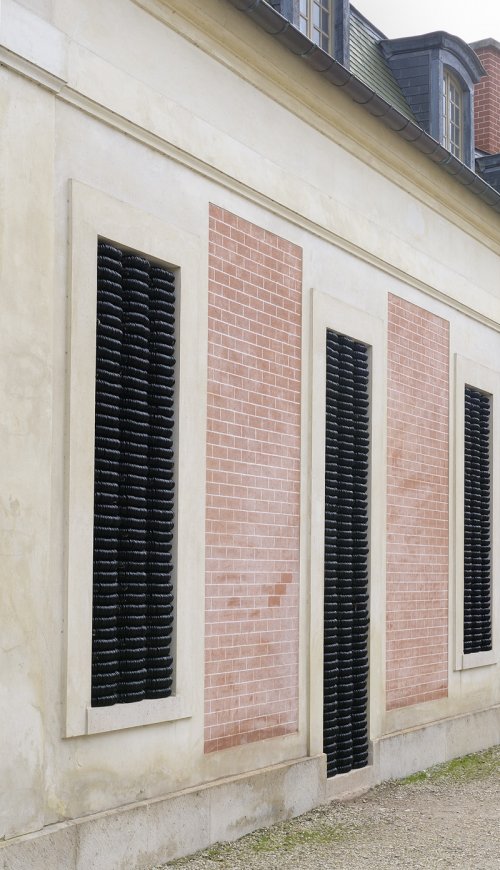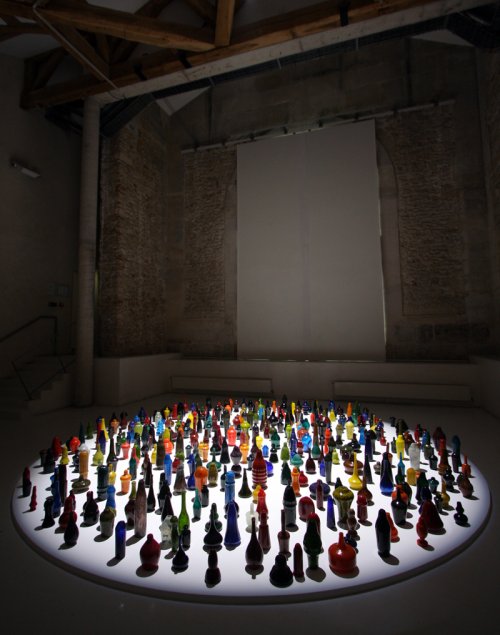Blow Bangles Production
Art Center - La Maréchalerie, Versailles, France. january 23 to March 31, 2013.
"By re-melting the tora, François Daireaux inverts the manufacturing process of the bracelets to recompact the matter. The imprint deals with the notion of absence, the loss of the original state, with ambiguity: each impress possesses a visible and a hidden face like a sort of “double-bottom drawer”. Taking the aspect of a design object, the imprint carries in itself the trace of its vanishing matter – the tora’s melting and the glass blowing into a mold, the string included – as an autonomous form, while the conglomerated bangles are still discernable, like fossilized into a new objet, cast in the process.
The fusion of a product into another or a matter in the receptacle of another is extremely violent in the squandering of necessary energy. The sixty-four minutes of film emphasize the different steps, the meticulous gestures and the numerous hours of work to produce a tora. This violence carries the political dimension of the project. In Firozabad, when he films the workers crouched in front of the “mills of necessity”, with their rudimentary tools fetching the glass by hand or inhaling the smoke of the plastic treads they find and burn, François Daireaux shows the harsh working conditions, the gap between a worker’s lifestyle and the public for this objects “manufactured by hand” in the primary sense. It’s in the sculptural extension of the 404 imprints that François Daireaux moves his political reflection a step further. There is no specific message but a stress on the creative process itself. The artist used the usual commercial channels making the series and became an actor of globalization (more than half of the production of Firozabad goes abroad), buying from the Firozabi sellers over many months to progressively fill a container to be sent to Meisenthal. The secular local craft, processes of which he had scrutinized for months, becomes a deterritorialized object relocalized in France. Daireaux reenacts the exchanging process of migration and networks, as economics and culture are intricately as part of the globalization process. Globalization has something to do with the origin of the glass industry in Firozabad, glass objects imported by successive invaders of India were then recycled by the Firozabis for the fabrication of bracelets. Daireaux explores the contradiction between local and global. But here he underlines the tension between the physically local and the locality in the filtering of the craft of one city through the mold from another as a direct confrontation with the effects of globalism: on one hand the glass of a local industry produced in enormous quantities in the full circle of the global market; on the other hand the glass from a local industry just managing amidst a national industrial crisis, the surviving glass industries in France being constantly challenged by foreign competition, especially the Indian.
The production of the 404 imprints involves a pure sculptural process, governed by the same rules as sculpture, transforming, altering matter (an entire production in this case) to gave it another shape, but what is interesting here is its global scale."
Extract of The world is a sculpture disregarding itself by Alexandrine Dhainaut
404
Inventory 404 colours of glass bangles from Firozabad
Firozabad
64’, color video, sound, no dialogue , 2013.
Firozabad (extract)
64’, color video, sound, no dialogue , 2013.
With Firozabad, François Daireaux visually extends the work in progress of Suite, a non-exhaustive inventory of craft gestures from all over the world started in 2004. Here the artist widens his frame of work from fragments to the bodies in action. Yet Firozabad, a succession of disparate scenes like a “pièce à tiroirs” explores the same theme: the cinematics of labor. In each factory, Daireaux captures the rhythmic, even hypnotic coordination of the bodies, individual movements and the forces inhabiting them. The film is even more choreographic, the ongoing ballet of the workers captivates: the declination of shapes from recycling to liquefaction, from soft reddish substance to the final solid product, in an infinite variety of colors and forms. The life-size framing renders the completeness of the immersion of the artist amidst the workers. He drops the stillness of Suite, changes scale then lets himself be guided by things passing in front of him. Thus the camera slides from one subject to another, from one shape to another, scrutinizing the details, the shapes’ spontaneous outcome, something not so familiar in Daireaux’ practice. Body-camera or body-container, he becomes a go-between, articulating the present forces and forms. Physically experimenting reality is essential to him. The artist stays very close to the glass matter and the workers, filming the bodies and faces in close-up, most of the time facing the camera. The filming is a single movement, grazing the bodies and the outlines of the forms.
The men’s movements and faces are bodily filmed; the skin’s omnipresence contributes to the sensuality, even sexuality transpiring from the images. François Daireaux multiplies shots of the workers hands maneuvering the blowpipes, the soft and loose forms of the glass, shots of necks, nude torsos, the resting (the film is punctuated with images of lying bodies or slack hands) or even the subtle hip swigs of the workers molding the matter. Thus the artist alternates inside shots of the factories and static shots of the walls around them: where there Hindi ads in white paint promote medicine for sexual aid. Referring to the Marxist theories which consider work and procreation as two modes of the same process of vital fertility, it is more the “preservation of the reproductive function” than the sexuality that is at stake. It is striking to see that, although absent from the Firozabi factories (with a few exceptions), the women’s body haunts the male universe pictured here, with this highly feminine accessory, the bangles.
Life and glass seem to be cast in the same cycle as in Firozabad, x-rays of rib cages hanging outside a street shop are inserted by Daireaux; they inevitably evoke the structure of the toras and the transparency of glass. One says that in Firozabad, the people are so absorbed with the glass industry that they don’t breath air but glass…"
Extract of The world is a sculpture disregarding itself by Alexandrine Dhainaut
See the video of the interview realized in CIAV with François Daireaux
https://vimeo.com/41484553












